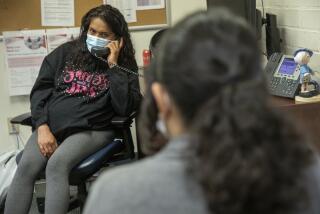Many Children, Few Preschool Slots
- Share via
Most publicly funded preschools in California have long waiting lists, shutting out thousands of poor children who could benefit from early learning programs, according to a new report on the consequences of the state’s preschool shortage.
The study -- to be released today -- found that 326,758 children ages 3 to 5 years old who were eligible for subsidized preschool were not being served. Seventy-six percent of publicly funded programs reported waiting lists that sometimes were years long.
In Los Angeles County, 861 preschools were queried, and 73% reported having waiting lists. In Orange County, where 129 programs were surveyed, 91% had waiting lists. A shortage of spaces was found across a spectrum of state and federally funded programs, including Head Start.
As a result, children most at risk for failing in school and for antisocial behavior are being denied the kind of education that has been proved to help them succeed.
“When low-income families get stuck on waiting lists, they have nowhere to turn,” said Brian Lee, co-author of the report. “It has repercussions for the family and child, and ultimately the whole community, if kids end up being a burden on society.”
Alvard Asatryan, a Glendale mother and wife, worries about whether she’ll be able to hang onto her new job as she struggles to find preschool for her 4-year-old daughter and 3-year-old son.
She has been on a waiting list with her local child-care resource center since August. Asatryan, a clerk for the county Department of Public Social Services since May, said her single, $2,000-a-month income places the family low on the list.
“I work from 7 a.m. until 3:30 p.m. and ask my mother-in-law to care for them,” Asatryan said. “But it’s hard. And I really want child care to be an opportunity for my kids to learn and have experiences with other kids.”
The report -- Public Safety Can’t Wait -- is the first comprehensive preschool survey conducted by Fight Crime: Invest In Kids California, a nonprofit anti-crime group led by the state’s sheriffs, police chiefs, district attorneys and crime victims. More than 2,000 preschools were surveyed.
“The numbers mentioned in the report are shocking to me, and I hope shocking to the public,” said Sheriff Robert Doyle of Marin County, who is president of the California State Sheriffs’ Assn. “Early preschool training is the key to success. It shouldn’t just be an option; it should be something that we as a society demand be funded.”
Doyle and Los Angeles County Sheriff Lee Baca spoke during a telephone conference call with reporters this week. Both men said giving children the right start could help prevent later crimes and violence.
The report cites several recent studies, including a 40-year research project at a Michigan preschool finding that children who attended the program were less likely to commit crimes as adults than those who didn’t attend.
Other research has shown that preschool attendance diminishes the achievement gap between disadvantaged and advantaged students. But most low-income families cannot afford to send their children to private preschools, where annual costs can exceed $3,000.
The Fight Crime group asserts that the state is failing to fund preschool programs adequately, and it opposes proposed state budget cuts to child-care programs.
But state officials said that of $304 million given to preschools last year, about $6 million reverted to the state because it wasn’t spent and $30 million more still hasn’t been used. “If it’s a question of money,” said H.D. Palmer, spokesman for the Department of Finance, “the track record isn’t that it’s underfunded but that it hasn’t been fully spent.”
Some officials discounted the report’s use of waiting lists as a measure of demand, saying families usually put their children on many such lists, rendering them inaccurate.
But other experts, including Bruce Fuller, an associate professor in the School of Education at UC Berkeley, said the surveys reflected their own findings.
The Fight Crime report found that only 43% of children from low-income households were served through subsidized programs. Further, children from families earning more than $60,000 a year were more than 50% more likely to be in preschool than those in families earning less than $30,000.
But the problem hits all income levels. According to the report, 72% of the 300 primarily private accredited preschools that responded to the survey had waiting lists.
At Culver City’s Westside Children’s Center, more than 200 youngsters are waiting for pre-school space. Competition for the 100 slots is based on need, with those in protective services receiving the highest priority, said Executive Director Richard Cohen. The center is within walking distance of low-income Mar Vista public housing projects, where most families qualify for subsidized care.
“Eighty percent of the children come here speaking only Spanish, and by the time they leave, they know their numbers and colors, they can write their names and know how to sit in a group,” Cohen said.
“But equally important, they are immunized, they have dental checks, and we make sure they are enrolled in whatever health plan they’re eligible for.”
More to Read
Sign up for Essential California
The most important California stories and recommendations in your inbox every morning.
You may occasionally receive promotional content from the Los Angeles Times.











